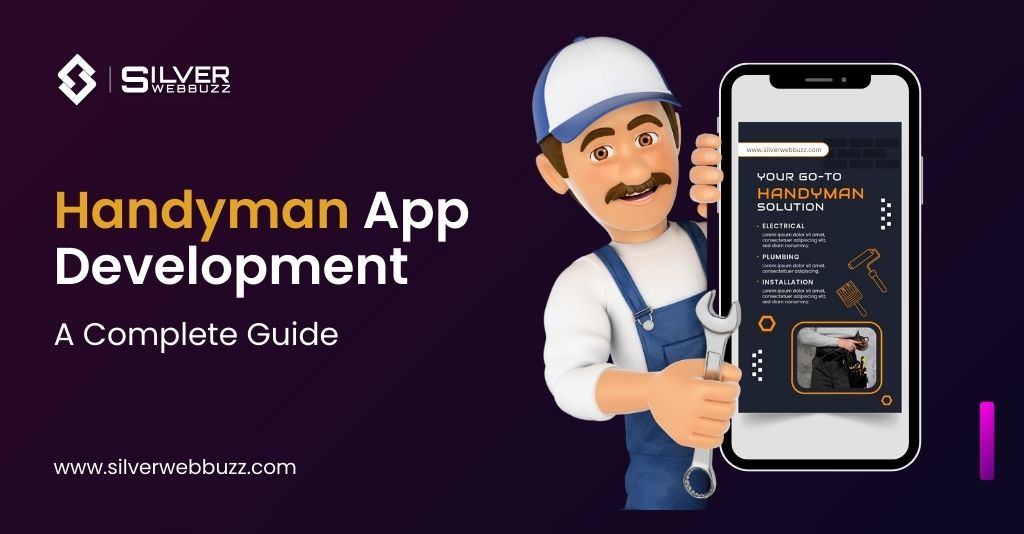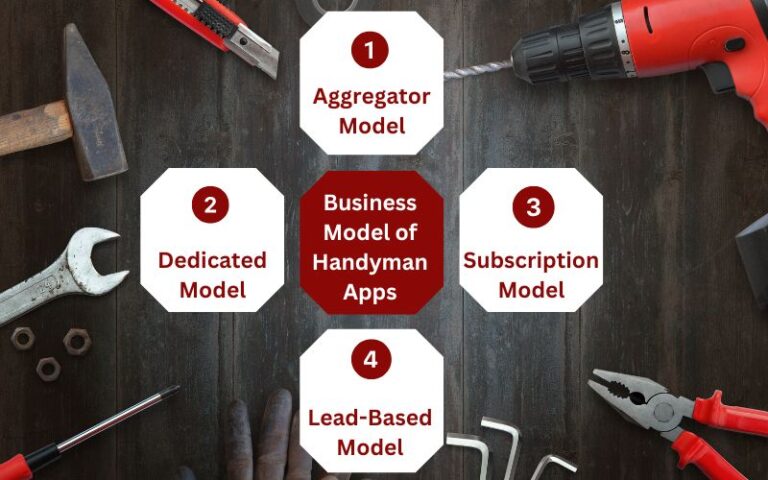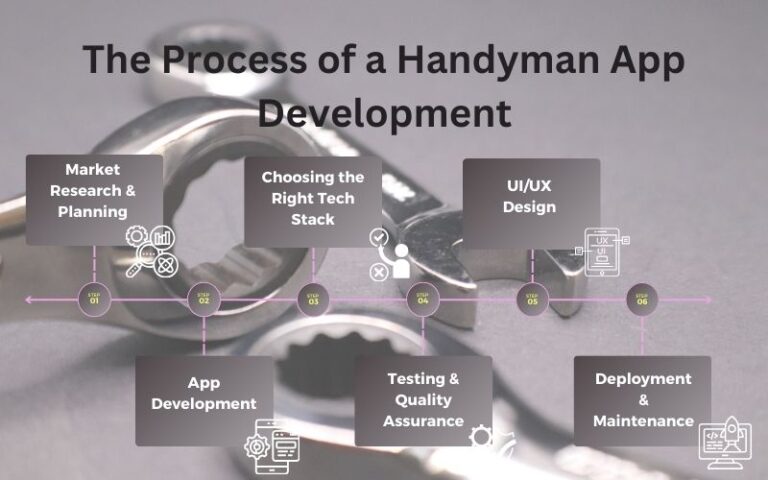
For businesses, investing in Handyman App Development presents a lucrative opportunity to tap into a growing market, improve service management, and enhance customer satisfaction. This guide explores the business model, benefits, features, development process, costs, challenges, and how we can help in building a top-notch handyman app.
What are Handyman Apps?
Business Model of Handyman Apps

1. Aggregator Model
How It Works:
- The platform registers multiple independent service providers.
- Customers browse available services, compare handymen, and book appointments.
- The app facilitates communication, booking, and payment processing.
- A commission is charged on each completed transaction.
Revenue Generation:
- Commission-Based Earnings: A percentage of the service fee is deducted as commission from service providers.
- Surge Pricing: Increased service charges during peak hours or high-demand seasons.
- Featured Listings: Service providers can pay to appear at the top of search results.
Advantages:
- No need to hire and manage service providers, reducing operational costs.
- Scalable model that allows quick expansion into new locations.
- Customers benefit from multiple options, competitive pricing, and better service quality.
Challenges:
- Managing a large number of service providers and ensuring quality control.
- Building trust between customers and independent handymen.
- Handling disputes, cancellations, and refunds effectively.
2. Dedicated Model
How It Works:
- The company recruits skilled handymen as employees or contractors.
- Services are offered directly under the company’s brand.
- Customers book appointments through the app, and the company assigns professionals accordingly.
- The company manages scheduling, payments, and customer support.
Revenue Generation:
- Direct Service Charges: Customers pay the company directly for the services.
- Membership Plans: Offering premium plans with benefits like priority booking and discounts.
- Cross-Selling & Upselling: Providing additional services such as home maintenance packages.
Advantages:
- Full control over service quality, customer experience, and pricing.
- Higher customer trust and brand loyalty due to direct service delivery.
- Easier to implement standardized procedures and employee training.
Challenges:
- High operational costs due to workforce salaries, training, and equipment.
- Limited scalability compared to aggregator models.
- Requires extensive marketing to attract and retain customers.
3. Subscription Model
How It Works:
- Customers or handymen subscribe to a monthly or yearly plan.
- Subscribers get access to premium services such as priority booking, lower service fees, or exclusive offers.
- Service providers may pay for premium accounts with added benefits like more visibility or reduced commission rates.
Revenue Generation:
- Customer Subscriptions: Charging users for premium membership plans.
- Service Provider Subscriptions: Charging handymen for access to better leads and features.
- Ad-Free Experience: Offering a paid version without advertisements.
Advantages:
- Predictable and stable revenue stream.
- Encourages long-term customer engagement and loyalty.
- Helps businesses offer exclusive features that enhance user experience.
Challenges:
- Convincing users to pay for a subscription when free alternatives exist.
- Requires high-quality services and consistent customer satisfaction to retain subscribers.
- Ensuring enough value-added benefits to justify the subscription fee.
4. Lead-Based Model
How It Works:
- Customers submit service requests, specifying their needs.
- The app matches the request with relevant service providers.
- Handymen pay a fee to access leads or respond to job requests.
- The transaction is completed between the customer and the handyman, without direct involvement from the app. inquiries. This model is widely used in home service marketplaces.
Revenue Generation:
- Pay-Per-Lead: Service providers pay a fee for each customer inquiry they wish to respond to.
- Premium Lead Packages: Offering bulk lead purchases at discounted rates.
- Verified Leads: Charging higher fees for exclusive, high-quality leads.
Advantages:
- Minimal operational costs since transactions happen directly between customers and providers.
- No need to manage bookings, payments, or service fulfillment.
- Appeals to freelancers and independent handymen looking for work.
Challenges:
- Difficult to ensure lead quality, as some may not convert into actual jobs.
- Service providers may hesitate to pay for leads without a guaranteed return.
- Requires continuous marketing efforts to attract a steady stream of customer inquiries.
How Do Handyman Apps Work?
Handyman apps follow a simple workflow to ensure seamless service delivery:
- User Registration & Profile Setup – Customers and service providers create accounts.
- Service Selection & Booking – Users browse available services, select a handyman, and schedule an appointment.
- Real-time Tracking & Updates – Users receive updates about service status and estimated arrival time.
- Service Execution & Payment – The handyman completes the task, and the user makes a payment through integrated options.
- Review & Rating System – Users rate and review the service, helping maintain quality standards.
Why Invest in Handyman App Development?
Growing Demand for On-Demand Services
Recurring Revenue Streams
Competitive Advantage
Scalability & Business Expansion
Benefits of Handyman App Development
Convenience for Customers
Recurring Revenue Streams
Increased Revenue & Business Expansion
Improved Customer Satisfaction
Efficient Workforce Utilization
Data-Driven Insights & Optimization
Key Features of a Successful Handyman App
User Panel
- Easy Registration & Login – Social media and email sign-ups.
- Service Browsing & Booking – Category-wise listings for easy selection.
- Real-Time Tracking – Live updates on service provider location.
- Secure Payment Gateway – Multiple payment options for convenience.
- Review & Ratings – Users can rate and review service providers.
Service Provider Panel
- Profile Management – Handymen can update their experience and skills.
- Job Requests & Accept/Reject Options – Service providers receive job notifications.
- Earnings Dashboard – A summary of completed tasks and earnings.
Admin Panel
- User & Provider Management – Oversee user and handyman activities.
- Service & Pricing Management – Control service categories and pricing structures.
- Analytics & Reports – Business insights for growth and decision-making.
The Process of a Handyman App Development

1. Market Research & Planning
2. Choosing the Right Tech Stack
3. UI/UX Design
4. App Development
The core handyman app development stage involves coding and integrating essential features such as login, service booking, payment gateways, and push notifications. Backend infrastructure is also set up.
5. Testing & Quality Assurance
6. Deployment & Maintenance
Cost of a Handyman App Development
A handyman app development costs depend on factors like complexity, features, and development team location. A basic app costs between $15,000 to $30,000, while an advanced solution with AI-driven features, GPS tracking, and real-time chat can cost $50,000 to $100,000.
Factors Influencing Development Cost
- App Complexity – More features lead to higher costs.
- Technology Stack – Native apps cost more than cross-platform ones.
- Development Team Location – Developer rates vary across regions.
- Third-Party Integrations – Payment gateways, maps, and APIs add to the cost.
The Challenges of a Handyman App Development
1. Competition in the Market
2. Ensuring Service Quality
3. Managing Real-Time Availability
4. Security & Data Protection
5. User Retention & Engagement
How Silver WebBuzz Can Help?
- Expert Mobile App Developers – Skilled in Android, iOS, and cross-platform solutions.
- Advanced Feature Integration – AI-powered recommendations, chat support, and more.
- Scalable & Secure Solutions – High-performing apps with robust security.
- Post-Launch Support & Maintenance – Ongoing updates and improvements.
Conclusion
Investing in a handyman app is a lucrative opportunity in the on-demand service industry. By integrating essential features and overcoming challenges, businesses can create a successful digital platform. Silver WebBuzz provides end-to-end development services, ensuring a seamless experience for businesses and customers alike. Now is the time to your handyman app development and revolutionize the service industry!
Want to Develop a Custom Handyman App?
Turn Your Handyman Business Digital! – Launch a powerful app tailored to your needs and grow your service business effortlessly with Silver WebBuzz.
Frequently Asked Questions
Related Posts
Medicine Delivery App Development: A
This blog explores the key benefits of Shopify, why it's...
Read MoreTop 12 Shopify Benefits For
This blog explores the key benefits of Shopify, why it's...
Read MoreHow Much Does it Cost
Here is the ultimate guide on Shopify App Development along...
Read More

